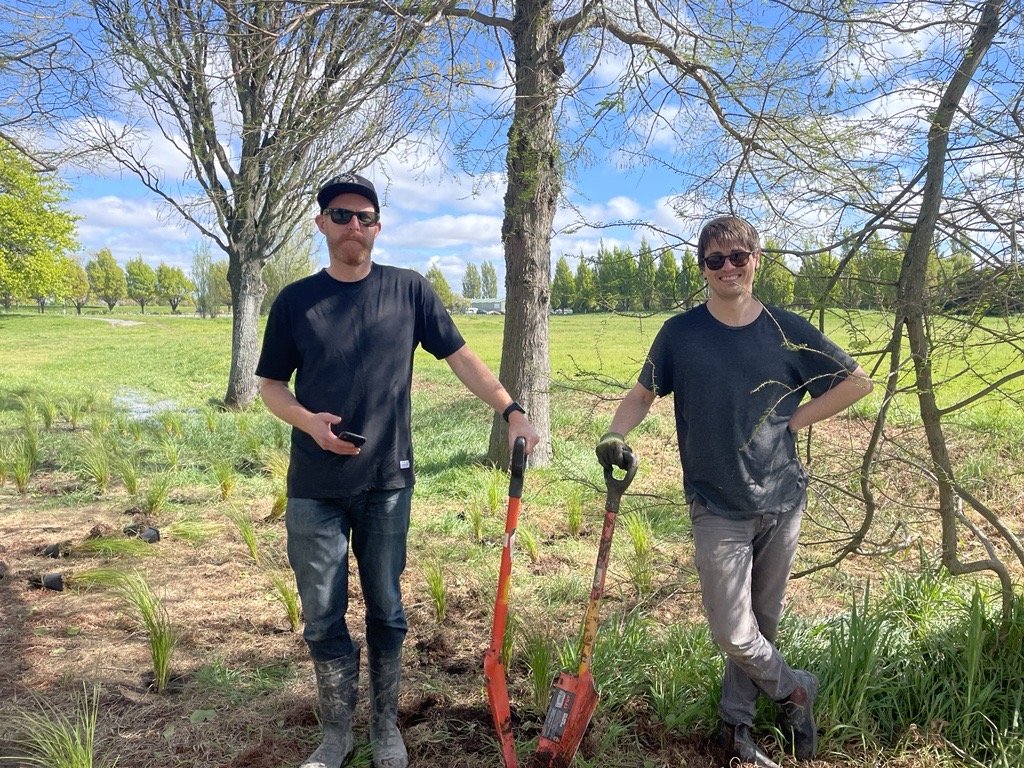An Upward Trajectory
Isthmus Principal Nik Kneale has spent the last decade or so helping shape Ōtautahi’s future in the wake of the Canterbury Earthquakes.
With life-long connections to the Ōtākaro Avon River and its disrupted communities, Nik reflects on the importance of acknowledging memory and connection to place in shaping a boldly aspirational future for the river, the land and the city.
Nik Kneale with Tom Holden, Isthmus Architect.
The first lines from my pepeha:
I whanau mai ai au, kei raro i te maunga, o Te Pōhue
I tipu ai au, ki te taha o te awa, o Ōtākaro
I tipu ai au, kei raro o te mana o Ngai Tahu, o Ngai Tūāhuriri hoki
I was born under Te Pōhue (Sugarloaf), a prominent peak on the Port Hills,
I grew up on the edge of the Ōtākaro Avon River, and
I grew up under the mana of Ngai Tūāhuriri, whose rohe includes Ōtautahi Christchurch.
I consider my connection to this place strong, particularly the areas adjacent to the Ōtākaro Avon River. The journey we’ve all been on over the last decade has cemented that in my mind. Growing up, my life was always adjacent to the river. Family homes, grandparents, schools, friends and clubs all involved engagement with the river in one way or another. When my wife and I returned to Ōtautahi and bought our first family home, this was the place we were drawn back to. So we invested in a home and settled into the community. Everything we needed was within 15 mins. The river led me to the city for work each day and it became part of my kids’ daily life, as it had for me.
And of course being close to the river became the reason our riverside communities failed in the Canterbury earthquakes. From the city to the sea, 10,000 people lived here and now they don’t.
I come back often, following the river on my bike with a mixture of memories and future opportunities in my mind. I often check on familiar places, all of which have changed physically but I’m still connected. Physical change doesn’t diminish the connection, in fact I feel it strengthens it.
I felt driven to explore this further through creation. A jeweller friend and I collaborated, following a fluid process where the end result was not known. What resulted was a series of sculptural pieces, each representing a home lost by my family through the red-zoning process, and all constructed using materials salvaged from red zone properties. Each is mapped through my childhood memories of the home, and what eventuated was a series of floor plans which bear limited resemblance to the architectural drawings, but are accurate through the eyes of a child in the place. Physical mind maps. The project allowed us to process what was happening, talking it out while creating something positive with our hands. We each have one of the pieces on our walls at home and the others are dispersed around Aotearoa. The memory of my Nan’s home hangs on the wall above me as I write this.
A memory from Nik Neale’s grandmother.
What I’ve come to realise is that loss doesn’t mean forgetting, in fact the process has strengthened my connection to the place. I think about it more, and I have the perspective to see the incredible benefits possible for our place and a drive to be a part of that journey. In death there is life.
With our whanau and friends, our Ōtautahi studio have started working with Christchurch City Council to advance the red zone’s evolution through our Mahia te Mahi programme— our annual ‘conservation day’ where we invest the Isthmus Environment Fund (IEF) staff time and resource in a day of environmental restoration and carbon sequestration.
And this year the site is right in my zone—
In one direction: my primary schools and family homes,
In another our old local shops and high school,
In another my old scout hall.
Isthmus Ōtautahi with friends and whanau, during our Mahia te Mahi day 2021.
And in the crosshairs, our incredible roopu (ages 1–40-something) working with the CCC rangers as part of the Council’s Ōtākaro Avon River regeneration programme. Our focus has been on Porritt Park, a place modified through river diversion for rowing, and in more recent memory a hub for hockey following its role in hosting the sport for the 1974 Commonwealth Games. Being surrounded by water, the park experienced significant land settlement and will never again be a place for field sports. While plans for future water sports expansion are discussed, we have taken the opportunity to focus on areas unaffected, pressing on with starting the restoration of the environment.
We’ve helped kickstart the next generation of this place; one that recognises the site’s desire to be a wet, ecologically rich landscape once again. One that improves the health and resilience of our wetland city and the aspirations of our communities to take an active part in creating a better place.
Today is always the best time to make positive change.
Yes, we’ve had to step back to step forward, but this first step forward feels great.
Mahia te mahi!



